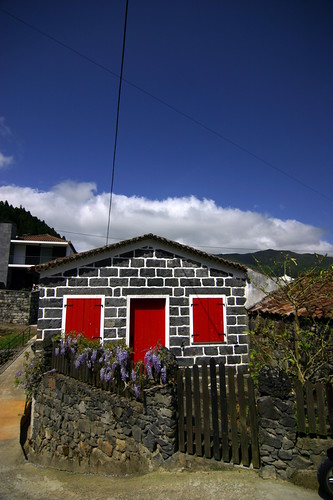The Azores (Portuguese: Açores) are a Portuguese archipelago in the Atlantic Ocean, about 1,500 km (950 mi) from Lisbon and about 3,900 km (2,400 mi) from the east coast of North America. The westernmost island (Flores) actually lies on the North American plate and is only 1,925 km (1,200 mi) from St. John's in the Canadian province of Newfoundland and Labrador.

The islands are, geologically speaking, young. The youngest, Pico, is only 200,000 years old and the other eight originated 1 to 5 million years ago.
The nine major Azorean Islands and the eight small Formigas extend for more than 600 km, and lie in a north west-south east direction. The vast extension of the islands defines an immense exclusive economic zone of 1.1 million km². The westernmost point of this area is 3,380 km from the North American continent.

All of the islands have volcanic origins, though Santa Maria also has some reef contribution. The mountain of Pico on Pico Island, at 2,351 m in altitude, is the highest in all of Portugal. The Azores are actually the tops of some of the tallest mountains on the planet, as measured from their base at the bottom of the ocean. The archipelago forms the Autonomous Region of Azores, one of the two autonomous regions of Portugal.
Though it is commonly said that the archipelago is named after the goshawk (Açor in Portuguese), because it was supposed to be a common bird at the time of the discovery. Some historians indicate the archaic Portuguese word "azures" (the plural of blue) because of the colour of the islands when seen from afar. Most, however, insist that the name is derived from birds, pointing to a local subspecies of the buzzard (Buteo buteo), as the animal the first explorers erroneously identified as goshawks.

The location, almost in the middle of the Atlantic, has a determining influence on the weather which can vary greatly from island to island. What is more, each island has its own character – that’s what makes traveling and hiking in the Azores so interesting.

The islands are, geologically speaking, young. The youngest, Pico, is only 200,000 years old and the other eight originated 1 to 5 million years ago.
The nine major Azorean Islands and the eight small Formigas extend for more than 600 km, and lie in a north west-south east direction. The vast extension of the islands defines an immense exclusive economic zone of 1.1 million km². The westernmost point of this area is 3,380 km from the North American continent.

All of the islands have volcanic origins, though Santa Maria also has some reef contribution. The mountain of Pico on Pico Island, at 2,351 m in altitude, is the highest in all of Portugal. The Azores are actually the tops of some of the tallest mountains on the planet, as measured from their base at the bottom of the ocean. The archipelago forms the Autonomous Region of Azores, one of the two autonomous regions of Portugal.
Though it is commonly said that the archipelago is named after the goshawk (Açor in Portuguese), because it was supposed to be a common bird at the time of the discovery. Some historians indicate the archaic Portuguese word "azures" (the plural of blue) because of the colour of the islands when seen from afar. Most, however, insist that the name is derived from birds, pointing to a local subspecies of the buzzard (Buteo buteo), as the animal the first explorers erroneously identified as goshawks.

The location, almost in the middle of the Atlantic, has a determining influence on the weather which can vary greatly from island to island. What is more, each island has its own character – that’s what makes traveling and hiking in the Azores so interesting.





































